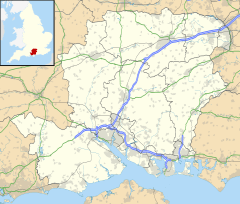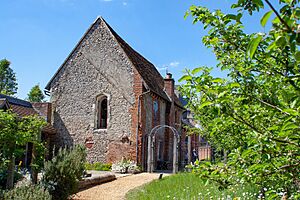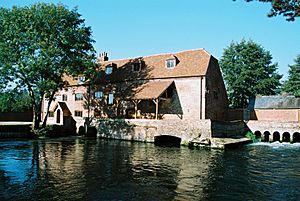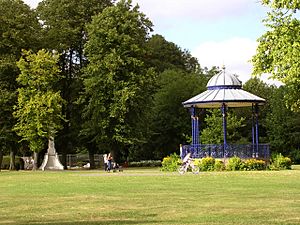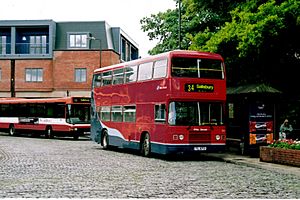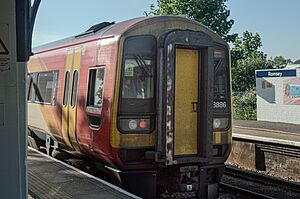Romsey facts for kids
Quick facts for kids Romsey |
|
|---|---|
| Market town | |
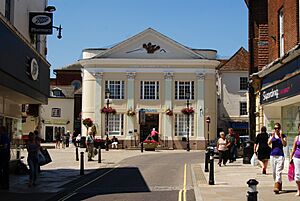 Romsey Corn Exchange |
|
| Population | 14,768 (2011 census, parish) |
| District |
|
| Shire county | |
| Region | |
| Country | England |
| Sovereign state | United Kingdom |
| Post town | ROMSEY |
| Postcode district | SO51 |
| Dialling code | 01794 |
| Police | Hampshire |
| Fire | Hampshire |
| Ambulance | South Central |
| EU Parliament | South East England |
| UK Parliament |
|
| Website | Romsey Town Council |
Romsey (/ˈrɒmzi/ ROM-zee) is a historic market town in Hampshire, England. A market town is a place where people used to gather to buy and sell goods. Romsey is located about 7 miles (11 km) northwest of Southampton. It is also 11 miles (18 km) southwest of Winchester. The town sits near the New Forest, a large area of woodland and open land. In 2011, Romsey had a population of 14,768 people.
Romsey is one of the main towns in the Test Valley area. It is built along the River Test, which is famous for fly fishing, especially for trout. In 2019, the town centre was updated. A large roundabout was removed, and a new area for people to walk was created.
Romsey has been home to several famous people. William Petty, a philosopher and economist, lived here in the 1600s. Lord Palmerston, a British Prime Minister in the 1800s, also lived in Romsey. His statue stands in the town centre. Later, Louis Mountbatten, 1st Earl Mountbatten of Burma, a naval officer, lived at Broadlands nearby. The impressive Romsey Abbey, the biggest parish church in Hampshire, is a key building in the town. Other important buildings include an old hunting lodge, a coaching inn, and a corn exchange.
Contents
History of Romsey
How Romsey Got Its Name
The name Romsey likely comes from "Rūm's Eg." This means "Rūm's area surrounded by marsh." Rūm was probably a short form of a person's name, like Rūmwald.
Early Days and the Abbey
Romsey Abbey was first built in 907. The village grew around this religious community. In 993, Vikings attacked Romsey and burned the church. But the town recovered, and the abbey was rebuilt with stone around the year 1000. The abbey became an important place for learning, especially for noble children. A market also started outside its gates.
The Domesday Book of 1086, a famous survey of England, mentions three mills in Romsey. These mills show that Romsey was an industrial town early on.
Norman Times and Royal Connections
The body of King William II, also known as "Rufus," was carried through Romsey. This happened after he died while hunting in the New Forest. His body was on its way to Winchester.
The Normans built the large Romsey Abbey we see today. It was built between 1120 and 1140 on the site of the older Saxon church. By 1240, about 100 nuns lived in the abbey.
King Henry I gave Romsey its first charter. This allowed the town to hold a market every Sunday. It also allowed a four-day fair each May. Later, in the 1200s, King Henry III allowed another fair in October.
Wool Trade and the Black Death
The wool industry helped Romsey grow a lot during the Middle Ages. Wool was woven, washed, and dyed here. Then, it was sent from nearby Southampton to other places.
However, the Black Death hit Romsey in 1348-1349. This terrible disease may have killed half of Romsey's 1,000 people. The number of nuns at the abbey dropped to only 19. The abbey never fully recovered its wealth.
The Abbey's End and New Beginnings
King Henry VIII closed the abbey in 1539 during the Dissolution of the Monasteries. Many religious buildings were destroyed then. But Romsey Abbey was saved because part of it was used as a church for the local people. The town bought the abbey from the King for £100 in 1544.
By the mid-1500s, Romsey had about 1,500 people. Its wool and tanning industries helped it grow. On April 6, 1607, King James I gave Romsey a new charter. This made it an official borough. It meant Romsey could have a mayor, aldermen, and a town clerk to manage its affairs.
English Civil War and New Industries
Romsey was fought over during the English Civil War. Both Royalist and Roundhead troops took control of the town. They also took goods from the town. Royalists held Romsey until January 1645.
Romsey's wool industry lasted until the mid-1700s. But it couldn't compete with wool from northern England. However, new businesses quickly started. These included brewing, papermaking, and sackmaking. All of these needed water from the River Test.
Collapsible Boats and Canals
In the 1800s, Romsey became known for making collapsible boats. These were invented by Rev. Edward Lyon Berthon in 1851. The Berthon Boatyard in Romsey made these boats from 1870 to 1917. They were used as lifeboats on large ships.
By 1794, a canal connected Romsey to Redbridge and Andover. But within 50 years, it was not used much anymore. Romsey was a fairly large town in the early 1800s. Its population was 4,274 in 1801.
Famous Residents and Royal Connections
Lord Palmerston, a British Prime Minister in the 1800s, lived at Broadlands. This is a large country estate near Romsey. His statue stands in the Market Place.
Broadlands later became the home of Lord Mountbatten of Burma. He was known locally as "Lord Louis." In 1947, he was given the title "Baron Romsey." Queen Elizabeth II's husband, Prince Philip, was his nephew. Philip and Elizabeth spent their honeymoon at Broadlands in 1947.
Lord Mountbatten was buried in Romsey Abbey after he was killed in 1979. After his death, his titles passed to his daughter, Lady Brabourne. Her eldest son was called "Lord Romsey" until 2005.
King Charles III (then Prince Charles) and his first wife Diana, Princess of Wales also spent part of their honeymoon at Broadlands in 1981.
Embley Park, a country estate near Romsey, was the home of Florence Nightingale. She is famous for her work as a nurse and for starting modern nursing. Nightingale is said to have felt her calling to help others while sitting under a large cedar tree at Embley Park in 1837. Today, Embley Park is a private school.
Nightingale is buried in a family vault at St. Margaret Church in East Wellow, near Romsey.
In 2007, Romsey celebrated the 400th anniversary of its charter. The Queen and the Duke of Edinburgh visited as part of the celebrations.
Romsey Today
While heavy industries have left Romsey, the town now has three industrial estates. These focus on service industries and small manufacturing. Three science and technology companies are also nearby: Roke manor research, Southampton Science Park, and IBM.
The town centre has a Waitrose supermarket and an independent department store called Bradbeers. There are also many other shops, both large chains and local independent stores.
How Romsey is Governed
Romsey is part of the Romsey and Southampton North area for the UK Parliament. Its current Member of Parliament (MP) is Caroline Nokes from the Conservative Party.
The town is part of the Test Valley district council. This council is currently controlled by the Conservative Party. Norton Knatchbull, 3rd Earl Mountbatten of Burma, Lord Mountbatten's grandson, is the current High Steward. This is an old position that dates back to the 1600s.
Romsey Town Council holds its meetings and has its offices at Romsey Town Hall.
Places to Visit in Romsey
Romsey Abbey
Romsey Abbey is a beautiful 12th-century abbey. It was built in the Norman style. It stands on the site of an even older Saxon church from the 900s. You can still see parts of the old Saxon church, like a 10th-century rood (a cross). The abbey is the largest parish church in Hampshire. Many people think it looks like a cathedral. It is open to visitors every day.
Broadlands Estate
Broadlands is a grand 18th-century country house just outside Romsey. It was designed by famous architects like Capability Brown. Many important people have lived there, including Lord Palmerston and Louis Mountbatten. Broadlands has hosted two royal honeymoons: Elizabeth II and Prince Philip in 1947, and Prince Charles and Princess Diana in 1981. The house and its gardens are open to visitors on summer weekday afternoons.
King John's House
King John's House is a building from the 1200s. People used to say it was a hunting lodge for King John. However, it was built in 1256, which is 40 years after King John died. But some parts might have come from an older building. The house has unique historical features. These include 14th-century wall drawings and old graffiti. It also has a floor made from animal bones and a traditional monastic garden. Some locals believe the house is haunted!
Embley Park Estate
Embley Park is a country estate on the edge of Romsey. It was the home of Florence Nightingale from 1825 until she died in 1910. Nightingale is known as the founder of modern nursing. She is said to have felt her calling to become a nurse in 1837 while sitting under a large cedar tree on the grounds. Today, Embley Park is home to Embley, an independent school.
The White Horse Hotel
The White Horse Hotel is an 18th-century coaching inn. Its wooden frames date back to the 1450s. Its old stone cellars suggest that guests might have stayed here as early as the 1100s. Lord Palmerston is said to have given his first political speeches in its assembly rooms.
Sadler's Mill
Sadler's Mill is the only mill built directly on the River Test. It was first recorded in the 1500s. It was used to grind corn. At one time, Lord Palmerston owned it. Milling stopped in 1932, and the building was empty for many years. It was restored in 2005. Scientists found that parts of the mill date back to the mid-1600s.
The Plaza Theatre
The Plaza, on Winchester Road, is an art deco style theatre with 230 seats. It was built as a cinema in the 1930s. Later, it became a bingo hall. In 1984, it was turned into a theatre. It is now home to a local drama group called RAODS. They put on many plays and shows each year.
Memorial Park
Romsey's Memorial Park hosts the annual Mayor's Picnic. It has a Japanese Type 96 15 cm howitzer. This is a type of large gun. It is one of two captured by the British and brought to Romsey by Louis Mountbatten. One was given to the town, and the other stayed at his home, Broadlands.
Romsey Signal Box
Built in 1865, the signal box controlled trains passing through Romsey until 1982. It was saved from being torn down. Now, it is a working museum where you can learn about old railway signals.
Other Interesting Places Nearby
- Sir Harold Hillier Gardens – Beautiful gardens and a tree collection.
- Mottisfont Abbey – A National Trust property with a famous rose collection.
- Paultons Park – A popular theme park for children.
Events in Romsey
The Mayor's Picnic happens in early summer at Romsey's Memorial Park. It features music from local schools and many stalls. A popular event is the Duck Race. Numbered plastic ducks float along the River Test, and prizes are given to those who chose the winning duck.
The Beggars Fair is a free festival held in Romsey's streets and pubs. It takes place on the second Saturday in July. It offers all kinds of music, dance, and street entertainment.
Romsey Carnival is a week-long event in July. The main highlight is a procession through the streets on the final Sunday afternoon.
The Romsey Agricultural & Horse Show is a big farming show. It happens on the second Saturday of September at Broadlands. It is one of England's oldest shows, held every year since 1842.
The Winter Carnival takes place when Romsey's Christmas lights are switched on each year.
The Romsey Arts Festival happens every three years. It shows off the talents of people from the local area.
The Romsey Beer Festival is organized by the local Round Table. It takes place in October or November at Crosfield Hall.
Romsey has two Rotary Clubs. They work with local businesses and schools to raise money for charity. The Rotary Clubs organize the annual Walk The Test Way. This walk helps hundreds of people raise money for good causes.
Famous People from Romsey
- Reverend W. Awdry – A clergyman and author of The Railway Series, which includes Thomas the Tank Engine.
- Edward Lyon Berthon – An inventor and clergyman.
- Laura Carmichael – An actress known for Downton Abbey.
- Charlie Dimmock – A TV gardening expert.
- David Gower – A famous retired cricketer.
- Louis Mountbatten, 1st Earl Mountbatten of Burma – Lived at Broadlands.
- Florence Nightingale – The founder of modern nursing.
- Lord Palmerston – A statesman and Prime Minister.
- William Petty – An economist and philosopher.
Education in Romsey
Schools Today
Romsey has several schools for different age groups.
State Primary Schools:
- Braishfield School
- Cupernham Infant School
- Cupernham Junior School
- Halterworth Primary School
- Romsey Primary School
- Romsey Abbey C of E Primary School
Independent Primary Schools:
- Stroud School
- Embley
State Secondary Schools:
- The Mountbatten School
- The Romsey School
Independent Secondary Schools:
- Embley
Getting Around Romsey (Transport)
Romsey is close to the M27 and M3 motorways. These roads provide quick links to the south coast and London. They also connect to the Midlands and the North. The A36 road is a few miles west of town. It offers a direct route to the West of England and South Wales. There are also bike paths to Southampton and Salisbury.
Romsey has a railway station. South Western Railway runs trains between Salisbury and Romsey, via Southampton. Great Western Railway also has services. These run between Cardiff and Portsmouth, stopping at Romsey.
Bus services are provided by Bluestar within Romsey and to Southampton. Salisbury Reds buses go to Salisbury and Southampton. Stagecoach buses go to Winchester.
Sports and Fun in Romsey
One of the cricket clubs in Romsey is Old Tauntonians and Romsey Cricket Club.
The Wessex League football club Romsey Town FC plays at The Bypass Ground.
Romsey Rugby Football Club is based at Ganger Farm. It has teams for all ages that play every weekend during the season.
The town also has a swimming pool called the Romsey Rapids.
Romsey in the Media
The Romsey Advertiser is the town's newspaper. It is published every Friday.
Romsey has been used as a filming location for TV shows. In the 1980s and 1990s, Romsey was the fictional town of Kingsmarkham in The Ruth Rendell Mysteries. Romsey locations appeared throughout the series. The police station was filmed at the old Romsey Magistrates' Court.
A fictional "underground car park in Romsey" was mentioned in an episode of the TV series Absolutely Fabulous.
Freedom of the Borough
The "Freedom of the Borough" is a special honour given to people or military groups. It means they have a special connection to Romsey.
Individuals Honoured
- Admiral of the Fleet Louis Mountbatten, 1st Earl Mountbatten of Burma: 1946.
Military Units Honoured
- The Royal Hampshire Regiment: 26 September 1959.
- The Princess of Wales's Royal Regiment received this honour in 1992. They inherited it from the Royal Hampshire Regiment.
|
See also
 In Spanish: Romsey para niños
In Spanish: Romsey para niños


